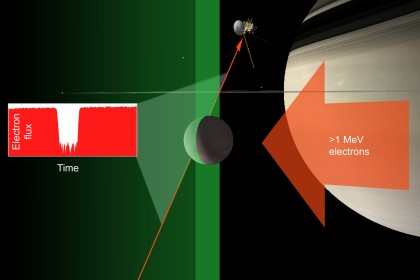|
Press Release 04/2006 - 10th March 2006
A little moon of Saturn makes its presence known
Max Planck researchers detect sub-surface material from the moon Enceladus in the magnetosphere around Saturn
The effects of plumes of ice and gas released from a small icy moon of Saturn can be detected over a million kilometers from the moon itself. The report, led by a team of scientists from the Max Planck Institute for Solar System Research in Katlenburg-Lindau, Germany, details how an instrument aboard the NASA/ESA Cassini spacecraft has detected "holes" in the magnetosphere: a bubble of charged particles surrounding Saturn. These holes are caused by Enceladus and material it has spewed out through open vents near its south pole. The results of these observations are reported in the journal Science (Science, 10 March 2006).

|
Figure: Saturn's moon Enceladus is bombarded by highly-energetic electrons that flow opposite to its motion around the planet (red arrow). On July 14th, 2005, the Cassini spacecraft passed downstream of this high-energy electron stream, and the LEMMS portion of the spacecraft's MIMI instrument recorded the sharp decrease in energetic electron fluxes (inset) in the region shadowed by the moon (green). Observations such as this one have allowed the MIMI team to investigate the interaction between Enceladus and the charged particles trapped around Saturn. Varying signatures at low electron energies indicate that Enceladus's plumes of water change in activity over the timescale of days or weeks.
(Image: MPS)
|
Enceladus measures only 500 km across, and is coated in a highly reflective layer made mostly of water ice. The NASA-led international  Cassini mission is in orbit about Saturn, making countless new discoveries about the planet and its many moons. During 2005, Cassini’s passed by Enceladus, and its instruments revealed the moon to be geologically active even today, billions of years after its formation. Cassini mission is in orbit about Saturn, making countless new discoveries about the planet and its many moons. During 2005, Cassini’s passed by Enceladus, and its instruments revealed the moon to be geologically active even today, billions of years after its formation.
The  MIMI instrument on the Cassini spacecraft is led by Johns Hopkins University Applied Physics Laboratory. One of its detectors, LEMMS, was built at the Max Planck Institute for Solar System Research (Max Planck Institut für Sonnensystemforschung). LEMMS measures the energy and direction of high energy ions and electrons. MIMI instrument on the Cassini spacecraft is led by Johns Hopkins University Applied Physics Laboratory. One of its detectors, LEMMS, was built at the Max Planck Institute for Solar System Research (Max Planck Institut für Sonnensystemforschung). LEMMS measures the energy and direction of high energy ions and electrons.
Like the Earth, Saturn is surrounded by a belt of these high-energy particles, called the radiation belts. Enceladus orbits the planet within the radiation belt, and is constantly being pelted by these particles. This bombardment of Enceladus causes material to be lost to the moon’s surface, and these losses are observed by LEMMS as holes or dropouts when passing close to the moon’s orbital path. Rather than seeing a clean dropout as is usually observed near icy moons, LEMMS observations show that the holes caused by Enceladus come in various depths and widths. Something is varying the way that Enceladus is interacting with Saturn’s magnetosphere, and the MIMI team suggest that it is the ice eruptions on Enceladus that are the cause. As these eruptions change in activity, the plume of gas and icy dust that lies near Enceladus also changes, causing the holes to change shape and depth.
"What we’re effectively doing is detecting from far away how this changing activity on Enceladus is affecting Saturn’s magnetosphere", says Dr. Geraint H. Jones from the Max Planck Institute for Solar System Research. "This complements very well what other Cassini instrument teams are seeing with completely different instruments on close passes to Enceladus. Scientists are studying the moon’s inside, its surface, atmosphere, and the effects on the magnetosphere. It’s a fantastic interdisciplinary study."
The Cassini mission’s phenomenal success is set to continue. Currently halfway through its 4-year survey of the Saturn system, scientists are anticipating further groundbreaking discoveries to take place.
Original publication
G. H. Jones, E. Roussos, N. Krupp, C. Paranicas, J. Woch, A. Lagg, D. G. Mitchell, S. M. Krimigis, and M. K. Dougherty
Enceladus' Varying Imprint on the Magnetosphere of Saturn
Science, 10 March 2006
Further informations
Dr. Geraint Jones
Max-Planck-Institut für Sonnensystemforschung
Max-Planck-Str. 2
37191 Katlenburg-Lindau
Tel.: 05556-979-205
Fax: 05556-979-240
E-Mail:  jones@mps.mpg.de
jones@mps.mpg.de
Elias Roussos
Max-Planck-Institut für Sonnensystemforschung
Max-Planck-Str. 2
37191 Katlenburg-Lindau
Tel.: 05556-979-413
Fax: 05556-979-240
E-Mail:  roussos@mps.mpg.de
roussos@mps.mpg.de
Dr. Chris Paranicas
Applied Physics Laboratory, The Johns Hopkins University
Laurel, MD 70723, USA
Tel.: +1 240 228 5000
E-Mail:  chris.paranicas@jhuapl.edu
chris.paranicas@jhuapl.edu
Prof. Michele K. Dougherty
Imperial College London
SW7 2BZ
London UK
Tel.: +44 2075947757
E-Mail:  m.dougherty@imperial.ac.uk
m.dougherty@imperial.ac.uk
|
